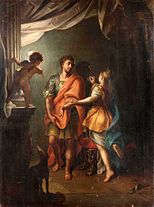
Jean Raoux (1677 – 10 February 1734), French painter, was born at Montpellier.
After the usual course of training he became a member of the Academy in 1717 as an historical painter. His reputation had been previously established by the acclaimed decorations executed during his three years in Italy on the palace of Giustiniani Solini in Venice, and by some easel paintings, the Four Ages of Man (National Gallery), commissioned by the grand prior of Vendôme. To this latter class of subject Raoux devoted himself, refusing to paint portraits except in character.
The list of his works is a long series of sets of the Seasons, of the Hours, of the Elements, or of those scenes of amusement and gallantry in the representation of which he was immeasurably surpassed by his younger rival Watteau. After his stay in England (1720) he lived much in the Temple, where he decorated several rooms. He died in Paris in 1734. His best pupils were Chevalier and Montdidier. His works were much engraved by Poilly, Moyreau, Dupuis, etc.

Gallery
-
 L'indiscrète (1728)
L'indiscrète (1728)
-
 Jeune femme lisant une lettre II
Jeune femme lisant une lettre II
-
 Jeune fille qui fait voler un oiseau (1717)
Jeune fille qui fait voler un oiseau (1717)
-
 Jeune fille au collier de perles
Jeune fille au collier de perles
-
 Vestal Virgin
Vestal Virgin
-
 Les petites musiciennes
Les petites musiciennes
-
 Pygmalion amoureux de sa statue (1717)
Pygmalion amoureux de sa statue (1717)
-
 L'origine du peinture Dibutades Tracing the Portrait of her Lover
L'origine du peinture Dibutades Tracing the Portrait of her Lover
-
 Mademoiselle Prévost, Bacchante
Mademoiselle Prévost, Bacchante
-
 Orpheus and Eurydice (c. 1718–1720)
Orpheus and Eurydice (c. 1718–1720)
-
 Antique Virgins (Left, 1727) and Moderne Virgins (right, 1728)
Antique Virgins (Left, 1727) and Moderne Virgins (right, 1728)
References
 This article incorporates text from a publication now in the public domain: Chisholm, Hugh, ed. (1911). "Raoux, Jean". Encyclopædia Britannica. Vol. 22 (11th ed.). Cambridge University Press. p. 898.
This article incorporates text from a publication now in the public domain: Chisholm, Hugh, ed. (1911). "Raoux, Jean". Encyclopædia Britannica. Vol. 22 (11th ed.). Cambridge University Press. p. 898.
Further reading
- Bénézit, Emmanuel (2006) . Benezit Dictionary of Artists. Vol. 11. Paris: Gründ. pp. 671–672. ISBN 2-7000-3081-8 – via the Internet Archive.
- Bataille, Georges (1928–1930). "Raoux". In Dimier, Louis (ed.). Les peintres français du XVIII-e siècle (in French). Paris, Bruxelles: G. Van Oest. vol. 2, pp. 267–282. OCLC 564527521.
- Dezallier d'Argenville, Antoine Joseph (1762) . Abregé de la vie des fameux peintres. Vol. 4. Paris: De Bure l'aîné. pp. 374–385. OCLC 1038747111 – via the Internet Archive.
- Heck, Michèle-Caroline (2009). Jean Raoux (1677–1734): peintre de la Régence (exhibition catalogue). Paris: Somogy. ISBN 978-2-7572-0287-6.
- Kalnein, Wend Graf ; Levey, Michael (1972). Art and Architecture of the Eighteenth Century in France. Harmondsworth: Penguin Books. OCLC 1008263215. SBN 14-056037-8.
- Klingsöhr–Le Roy, Cathrin (1996). "Raoux, Jean". In Turner, Jane (ed.). The Dictionary of Art. Vol. 25. New York: Grove's Dictionaries. pp. 895–896. ISBN 1-884446-00-0 – via the Internet Archive.
- Mesuret, Robert (1979). "Raoux (Jean)". In Laclotte, Michel (ed.). Petit Larousse de la Peinture. Vol. 2. Paris: Librairie Larousse. p. 1533. ISBN 2-03-020149-9.
- Myers, Bernard S., ed. (1969). "Raoux, Jean". McGraw-Hill Dictionary of Art. Vol. 4. New York: McGraw-Hill. p. 477. OCLC 1150274387 – via the Internet Archive.
- Percival, Melissa (2017) . Fragonard and the Fantasy Figure: Painting the Imagination. London, New York: Routledge. ISBN 978-1-4094-0137-7 – via Google Books.
- Réau, Louis (1925–1926). Histoire de la peinture du XVIIIe siècle (in French). Bruxelles, Paris: G. Van Oest. vol. 1, p. 65. OCLC 491647984.
- Thuillier, Jacques; Châtelet, Albert (1964). French Painting. Geneva: Skira. OCLC 1193944713 – via the Internet Archive.
- Vollmer, Hans, ed. (1934). "Raoux, Jean". Allgemeines Lexikon der bildenden Künstler (in German). Vol. 28. Leipzig: E. A. Seemann. pp. 14–15.
External links
- Entry and example at the Getty Museum in Los Angeles, CA